Don't eat after 8 p.m. Wait—don't eat before noon? Have a glass of red wine; it's good for your heart! Actually, no amount of alcohol is good for your health. Nix the carbs. Nix the red meat. Nix the eggs.
Navigating today's conflicting advice about nutrition can be confusing. Food myths—those pronouncements about what we should eat and when—are seemingly everywhere. But just how do these half-truths originate, and how do they spread into the mainstream?
"How much time do you have?" says Liz Nussbaumer, a project director with the Johns Hopkins Center for a Livable Future, with a laugh. "No, I'm kidding. It's a very good question."
"Nowadays, it's social media and access to the internet," answers Selvi Rajagopal, a Johns Hopkins obesity medicine specialist. "Finding answers on Google is a finger touch away, so it's really just easy and available information coming from all sources."
"We're used to viewing social media on our phones, and we just quickly scroll," adds Christine McKinney, a registered dietitian with Johns Hopkins. "We might only be seeing the headline or maybe the first two sentences. We're maybe not getting the full story or reading all of what was in the article." And, she adds, we're certainly not fact-checking everything that comes across our feed.
Beyond those "fitfluencer" TikToks and health blogs, they add, there are ad campaigns from major multinational corporations seeking to influence consumer habits; lobbyists who want a say in what goes onto your local elementary school's lunch menu; and, of course, your well-intentioned friends sharing the latest fad diet guaranteed to help you LOSE THREE INCHES—FAST.
Eager to cut through the noise, we turned to a panel of experts for the truth—the science-backed, evidence-based, fact-checked truth—behind some common food myths.
You should drink eight glasses of water a day
The verdict: Fill that Stanley cup, but don't stress too much
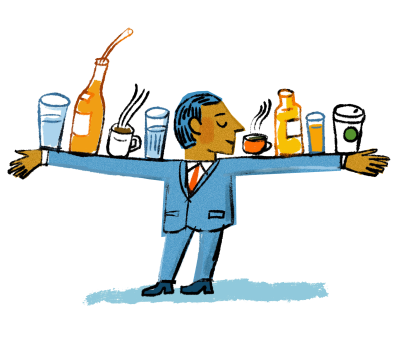
Image credit: Robert Neubecker
First off, McKinney asks, what size glass are we talking? "I find that so funny because we all drink out of different size glasses," she says. The National Academy of Medicine recommends a daily water intake of 15 cups for men and 11 cups for women. But McKinney notes that about 20% of that water can come from foods such as fruits and vegetables. "And fluids like coffee, tea, sparkling waters, juice, even soda or sweetened beverages, all of that does technically count toward our overall fluid intake," she says.
Generally speaking, eight, 8-ounce glasses of water is a good starting point, she says. Drinking water can help with weight management, digestion, healthy joints, and even regulating body temperature. If you don't want the bother of tracking your fluids, McKinney suggests keeping it simple. Is your urine a pale yellow? Are you thirsty? If the answer is yes and no, respectively, you're likely in good shape.
Don't eat past 8 p.m.
The verdict: +1 for the early bird special
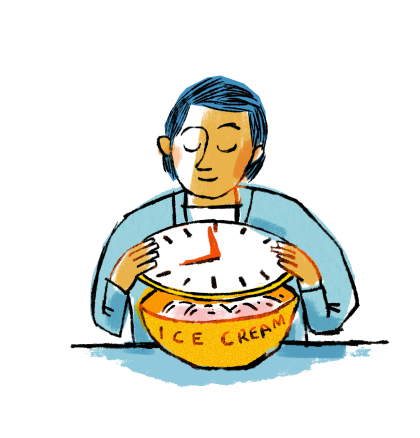
Image credit: Robert Neubecker
This one's complicated, but the consensus is that there is some truth to the old adage not to eat after 8 p.m. While "calories don't magically count more at night just because they were consumed at night," McKinney says, eating later in the evening has been shown to impact our hunger and satiety hormones, even into the next day. And some research has shown that eating before bed is linked to less restful sleep. "I like the idea of encouraging people not to eat two to three hours before going to bed, just to give your body time to digest," she says. "Otherwise, you're trying to go into sleep mode and your body's still working on digestion."
Rajagopal adds that our bodies are more active during the day, so we burn through energy from food much more efficiently. "Even if you're sitting at a desk doing work, your brain still needs energy, your body needs energy," she says. Toward the end of the day, she says, our bodies don't process glucose as efficiently, causing a higher spike in blood sugar and insulin each time you eat. "Which means we're storing more of what we eat. You're more likely to gain weight, and you're more likely to develop insulin resistance if you keep eating most of your meals later."
One final note: McKinney says to take note of the types of foods you tend to reach for after 8 p.m.—is it ice cream, popcorn, chips, and cookies? Might be best to close the kitchen after dinner.
Raw veggies are more nutritious than cooked ones.
The verdict: Cooked vegetables get a raw deal
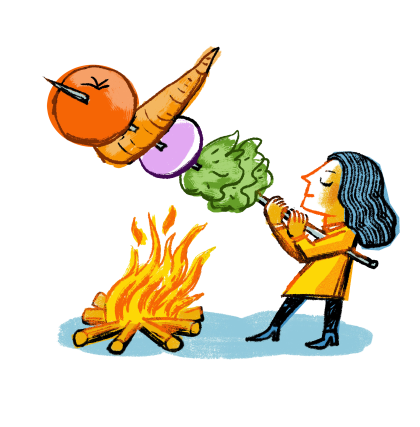
Image credit: Robert Neubecker
It is true that some nutrients are lost during the cooking process, McKinney says, particularly when vegetables are boiled, cooked at high temperatures, or heated for longer periods of time. But, she says, cooking also increases the availability of nutrients in some veggies. For example, our bodies better absorb lycopene, an antioxidant linked to improved heart health and reduced risk of certain cancers, from cooked tomatoes than raw. "Also, the availability of calcium or magnesium can be increased by cooking vegetables. Carotenoids—they're found in yellow, orange, and red vegetables—are converted to a form of vitamin A that is better absorbed when cooked." Not to mention, a plate of roasted broccoli topped with lemon, pepper, and parmesan cheese might just lead you to eat a few more nutrient-packed bites than a raw veggie platter. Your best bet, McKinney says, is to incorporate a combination of raw and cooked vegetables into your weekly menu.
Cut the carbs for health.
The verdict: Whole grains, whole lot of benefits

Image credit: Robert Neubecker
As a doctor who regularly sees patients concerned about diabetes, Rajagopal says the No. 1 myth she hears is that carbs are a no-no. "It's not so much that carbohydrates are somehow the devil," she says. Diets that are rich in whole, complex grains are good for long-term health and reduce your risk of cardiovascular mortality. "But nobody says that. Everybody is too busy saying that it's bad for you."
Avoid highly processed options like white bread, she says, which have been stripped of vital nutrients such as protein, fiber, vitamins, and minerals. "By the time it gets to you, the consumer, your body is doing virtually no work to absorb it, so your blood sugar rises rather quickly because there's really no barrier to entry," she says.
Rajagopal says it's important for people to educate themselves on how to read food labels in order to make wise choices. Start with the USDA's website, she says. A few quick tips: Look for whole grains versus processed ones, such as enriched white flour; fiber is your friend; and the less added sugar, the better.
Juice and smoothies are health food.
The verdict: It's a Vita-mixed bag

Image credit: Robert Neubecker
Define a smoothie, Rajagopal challenges readers. "It's just a general catchall term for blending things together. It could be a milkshake! So, it depends on what's in that blender." A pre- or post-workout smoothie with whole fruits (skin and all), protein, and greens could be a great choice to provide energy and help rebuild muscles, she says. But a sugar bomb with pineapples, bananas, and honey may lead to a blood sugar spike for a less active person with prediabetes. As for juice, proceed with caution. Conventional store-bought juice frequently contains more sugar and less fiber, antioxidants, vitamins, and minerals than whole fruit, Rajagopal says. 100% fruit juices, which may contain pulp, are more nutrient-dense but still have a high concentration of sugar compared to whole fruits.
Wild-caught seafood is better than farmed.
The verdict: Either way, it's a net win
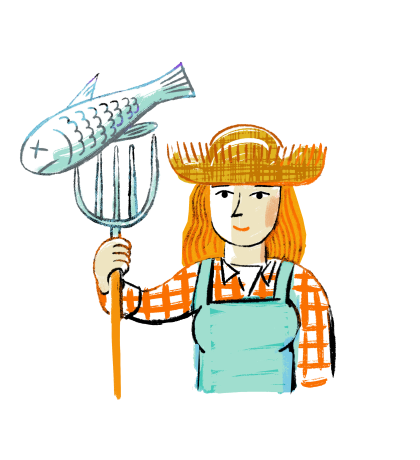
Image credit: Robert Neubecker
Wild salmon is leaner, while farmed salmon is higher in essential omega-3 and omega-6 fatty acids, says Liz Nussbaumer, director of the Seafood, Public Health & Food Systems Project at the Johns Hopkins Center for a Livable Future. Nutritionally, she says, "both are sufficient—it's not like either one is under the recommended amount." When planning your meals, the seafood experts at the Center for a Livable Future say it's far more important to think about the type of fish, the cut, and the method of cooking.
"Are you eating just the filet, which is still often protein-rich, but may be missing some of the micronutrients?" she asks. "Or are you eating a small, whole fish, where you're getting a lot of micronutrients from the head, calcium from the bones, and vitamin A from the eyes?" Seafood from marine and freshwater aquaculture is a primary source of nutrients for millions of people around the world. And "whether it's farmed or wild, it's often nutrient-dense," she says. "It's lean protein, it has healthy fats, and it's more sustainable than beef or pork."
Eating fat makes you fat.
The verdict: Don't fear the F-word
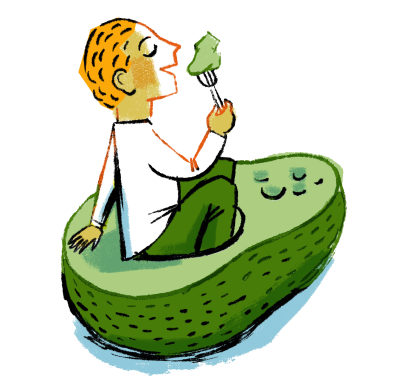
Image credit: Robert Neubecker
Dietary fat doesn't automatically become body fat, McKinney advises. Research shows that moderate- or even high-fat diets, including keto, can help people lose just as much weight as a low-fat diet. "Fat is more calorie-dense, so that can be concerning for some people, but fat has a lot of good roles in our bodies, too," she says. Fat helps us stay warm, absorb nutrients, and produce hormones. And, importantly, it helps us feel full for longer. Stick to unsaturated fats—avocados, nuts, seeds, and oils—rather than saturated fats like butter, cheese, fried foods, and red meat, which can increase your risk of heart disease or stroke, she says.
Posted in Health
Tagged nutrition, food, consumer behavior, diet, misinformation








